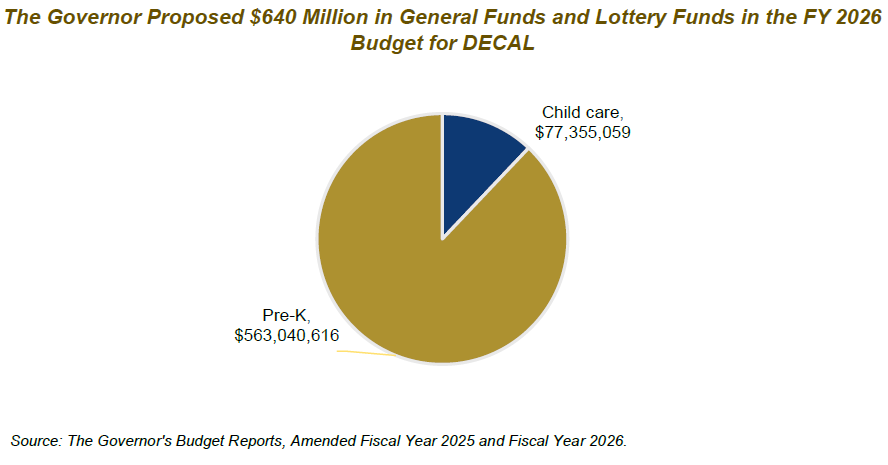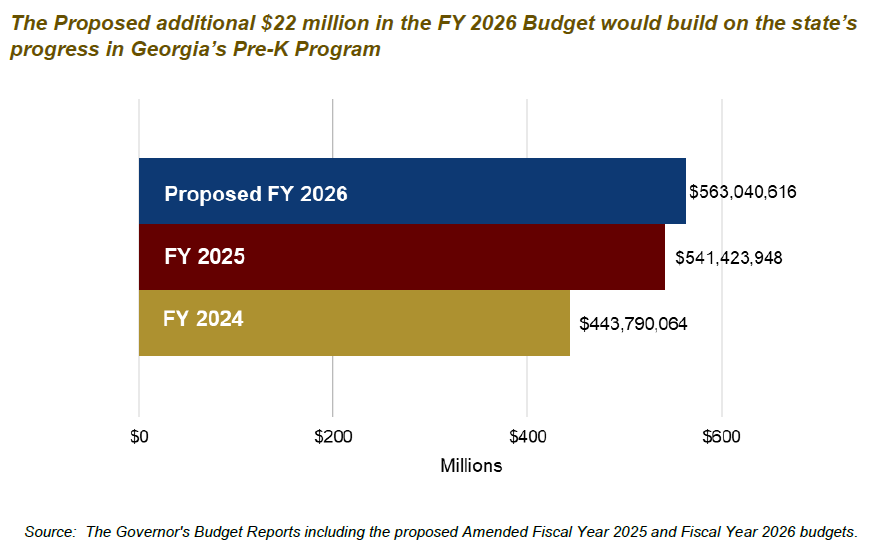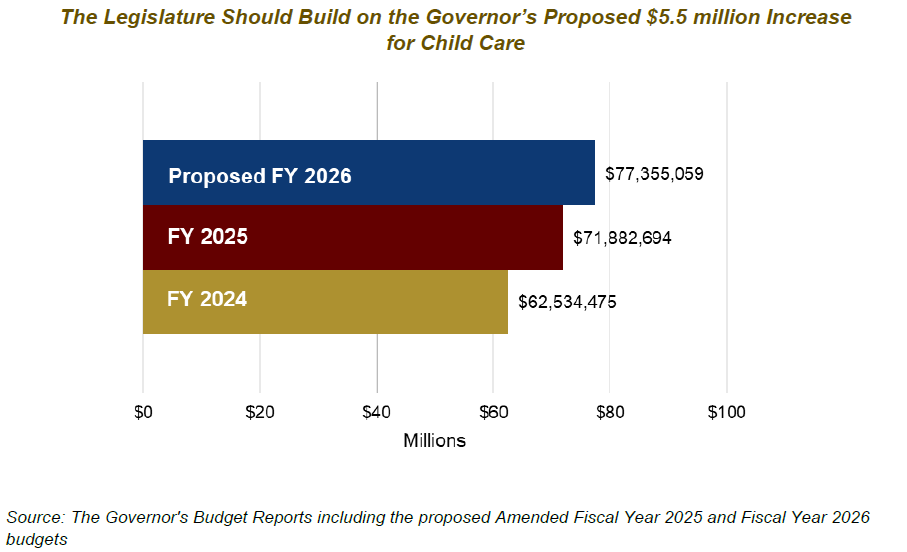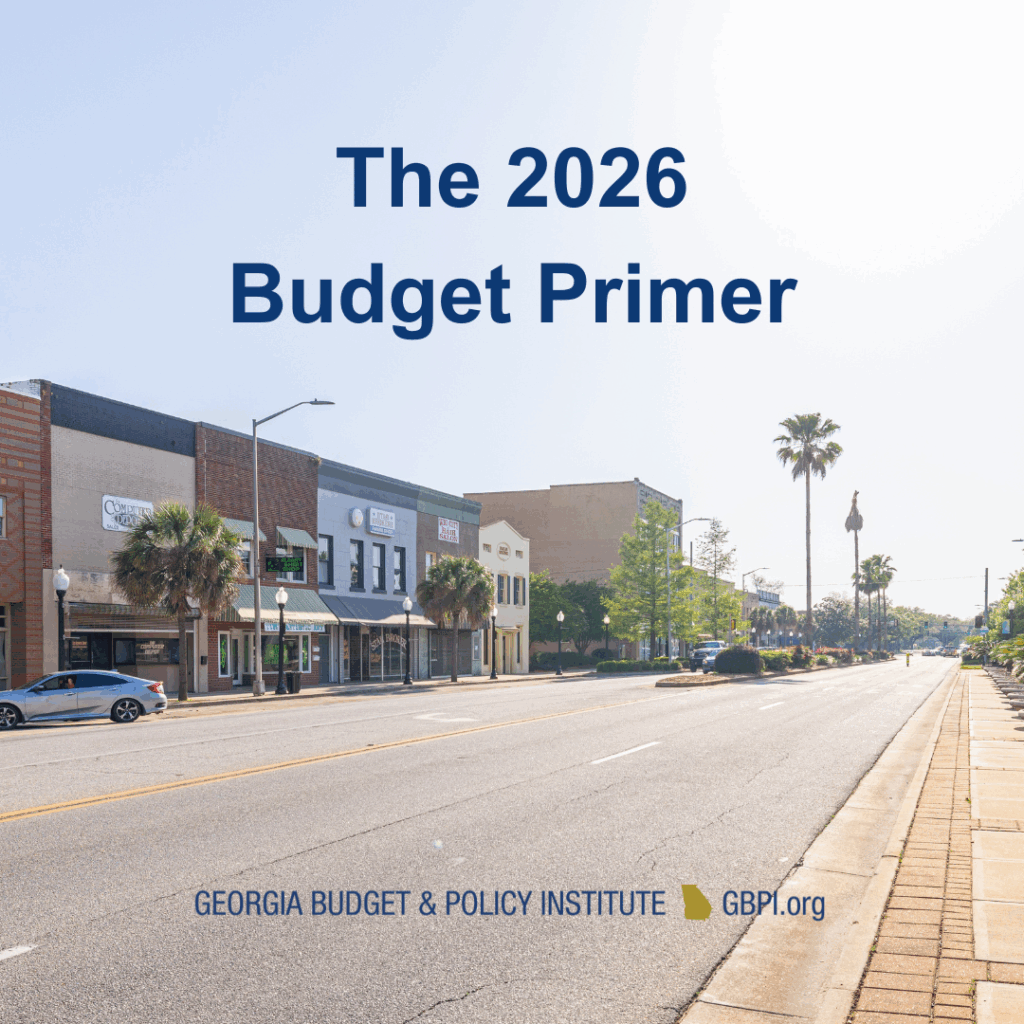Introduction
The Department of Early Care and Learning (DECAL) administers: Child Care Services; the Georgia Pre-kindergarten Program; Nutrition Services, which administers the federal Child and Adult Care Food Program; the Summer Meals program for low-income children in daycare facilities; and Quality Initiatives, which works to improve the quality and accessibility of child care programs.
State general funds support Child Care Services, and state lottery funds support the pre-K Program.
The Governor proposed sending $621 million to DECAL in his Amended Fiscal Year (AFY) 2025 budget and $640 million in his Fiscal Year (FY) 2026 budget. This would be a 4% increase between FY 2025 and FY 2026.[1]

While funding for pre-K is more aligned with the needs of the program, funding for child care remains woefully inadequate. The care of young children has historically been seen by society as women’s work inside the home. In Georgia and other Southern states, it’s been Black women’s work outside the home since the end of enslavement. It is, therefore, uncoincidentally, one of the lowest-paid professions in the state and country.[2] Time and time again government has failed to see child care’s critical role to families and the economy.[3] Mothers often cannot work as much as they want or pursue better jobs because of lack of affordable and adequate child care arrangements. Quality child care is unaffordable for the typical family in most Georgia counties, but it is a greater expense for Black and Latinx families.[4] Meanwhile, the state economy loses at least $1.75 billion annually due to child care challenges and the state loses at least $105 million in tax revenue.[5] This legislative session lawmakers could do more to support child care providers, families, and the economy through significant public investment in the child care system.
Budget Highlights for DECAL’s Pre-K and CAPS programs
Amended Fiscal Year 2025 Budget
- $7.4 million increase to continue to support pay parity between pre-K teachers and Kindergarten to 12th grade (K-12) teachers by moving to the State Board of Education salary schedule
- $100,000 increase for startup grants to establish additional Summer Food Service Program meal sites
Fiscal Year 2026 Budget
- $14 million increase for year two of a four-year phase in to reduce the maximum pre-K class size from 22 to 20
- $5 million increase for an update to pre-K teacher training (formula funds increase)
- $4 million increase for an additional 500 Childcare and Parent Services (CAPS) scholarships[6]
- $1.5 million increase to annualize the state match for CAPS reimbursement to the 60th percentile of the market rate[7]
The Governor’s Pre-K Proposals Would Continue Progress from Last Year; Child Care Needs Far More Support
Last year state leaders provided almost $100 million in additional funding for the pre-K program. That increase went to funding pay increases for pre-K lead and assistant teachers to make their pay more comparable to their K-12 counterparts, reducing class sizes, providing start-up and operational grants and improving student transportation. The governor proposes another $7.4 million in his amended budget to ensure pay parity between pre-K teachers and K-12 teachers and $14 million in the FY 2026 budget for year two of the class reduction phase in. If approved by the legislature, these proposals will continue to strengthen the state’s pre-K program.

Child care also saw some funding increases last year but far less than what the system needs. For FY 2025, the legislature approved a $9.3 million increase to the CAPS program. The agency is using the additional state resources to increase the reimbursement rate to child care providers that accept CAPS scholarships from the 25th percentile of the market rate to the 60th percentile. The proposed $1.5 million in the governor’s FY 2026 budget will also support that effort. With these moves, the state will finally be in compliance with federal reimbursement rules.

However, the program also lost more than $170 million in federal COVID-era relief funding in September 2024. That additional federal funding temporarily bolstered the program in new ways: it added an additional 22,000 CAPS scholarships and enhancements to support providers.[8] DECAL has since rolled back those expansions. The governor’s proposal of funding 500 additional CAPS slots is small compared to the scholarships the state lost after the end of the federal relief funding.
Georgia Needs Child Care Investments That Support Providers, Teachers, Families and Our Economy
The Georgia General Assembly should build upon the governor’s initial proposals and legislate many of the ideas from the Study Committee on Access to Affordable Child Care, which convened in Fall 2024.[9] They should:
- Expand the number of CAPS scholarships to lower the cost for more Georgia families
- End the regional variation in reimbursement rates to improve support for providers outside of the Atlanta metropolitan area
- Make child care teachers a priority group for receiving CAPS subsidies
To pay for these improvements lawmakers should increase appropriations for the CAPS program by at least $20 million and should pass a constitutional amendment to create a child care trust fund that uses funds from the undesignated reserve,[10] which could provide significantly more funding for the whole system long-term. These investments could help to remake a system that still operates on racial and gender inequity and fails to adequately support families and the economy.
Endnotes
[1] Governor’s Office of Planning and Budget. (2025, January 16). The governor’s budget report: amended fiscal year 2025 and fiscal year 2026. https://opb.georgia.gov/document/governors-budget-reports/afy-2025-and-fy-2026-governors-budget-report/download.
[2] Lloyd, C.M. , Carlson, J., Barnett, H., Shaw, S., and Logan, D. (2021, September). Mary Pauper: A historical exploration of early care and education compensation, policy, and solutions. Child Trends. https://earlyedcollaborative.org/what-we-do/mary-pauper/.
[3] Vogtman, J. (2017). Undervalued. A brief history of women’s care work and child care policy in the United States. National Women’s Law Center. https://nwlc.org/resource/undervalued-a-brief-history-of-womens-care-work-and-child-care-policy-in-the-united-states/.
Sethi, S. Johnson-Staub, C., Gallagher Robbins, K. (2020, July). An anti-racist approach to supporting child care through covid-19 and beyond. CLASP. https://www.clasp.org/publications/report/brief/anti-racist-approach-supporting-child-care-through-covid-19-and-beyond/.
[4] Finch Floyd, I. (2024, May 21). From barriers to bridges: Expanding access to child care and improving upward mobility for Georgia’s child care workers. Georgia Budget and Policy Institute. https://gbpi.org/from-barriers-to-bridges-expanding-access-to-child-care-and-improving-upward-mobility-for-georgias-child-care-workers/.
[5] Goldberg, H., Cairl, T. and Cunningham, T. (2018). Opportunities lost; How child care challenges affect Georgia’s workforce and economy. Georgia Early Education Alliance for Ready Students and the Metro Atlanta Chamber. https://geears.org/wp-content/uploads/Opportunities-Lost-Report-FINAL.pdf.
[6] CAPS provide assistance to help families afford the cost of child care.
[7] Governor’s Office of Planning and Budget. (2025, January 16). The governor’s budget report: amended fiscal year 2025 and fiscal year 2026. https://opb.georgia.gov/document/governors-budget-reports/afy-2025-and-fy-2026-governors-budget-report/download.
[8] In an average year, DECAL typically serves about 50,000 children in a given week. Using federal relief dollars, the agency temporarily boosted the number of children receiving CAPS scholarships to about 72,000 a week.
DECAL’s August 2024 presentation to the Board of Early Care and Learning. https://www.decal.ga.gov/documents/BoardMeetings/2024-08-22_Board_Presentation.pdf.
[9] Senate Office of Policy and Legislative Analysis. (2024, December). Final report of the Senate study committee on access to affordable child care (SR 471). https://www.legis.ga.gov/api/document/docs/default-source/senate-press-office-document-library/2024/study-committees-2024/12-12-affordable-childcare/final-report-childcare-study-committee.pdf?sfvrsn=91f38bbb_2.
[10] Kanso, D. (2023, October 31). Georgia’s $16 billion question: Will the state equitably invest in its people? Georgia Budget and Policy Institute. https://gbpi.org/georgias-16-billion-question-will-the-state-equitably-invest-in-its-people/









